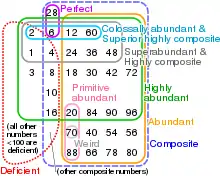
In mathematics a primitive abundant number is an abundant number whose proper divisors are all deficient numbers.[1][2]
For example, 20 is a primitive abundant number because:
- The sum of its proper divisors is 1 + 2 + 4 + 5 + 10 = 22, so 20 is an abundant number.
- The sums of the proper divisors of 1, 2, 4, 5 and 10 are 0, 1, 3, 1 and 8 respectively, so each of these numbers is a deficient number.
The first few primitive abundant numbers are:
The smallest odd primitive abundant number is 945.
A variant definition is abundant numbers having no abundant proper divisor (sequence A091191 in the OEIS). It starts:
Properties
Every multiple of a primitive abundant number is an abundant number.
Every abundant number is a multiple of a primitive abundant number or a multiple of a perfect number.
Every primitive abundant number is either a primitive semiperfect number or a weird number.
There are an infinite number of primitive abundant numbers.
The number of primitive abundant numbers less than or equal to n is [3]
References
- ↑ Weisstein, Eric W. "Primitive Abundant Number". MathWorld.
- ↑ Erdős adopts a wider definition that requires a primitive abundant number to be not deficient, but not necessarily abundant (Erdős, Surányi and Guiduli. Topics in the Theory of Numbers p214. Springer 2003.). The Erdős definition allows perfect numbers to be primitive abundant numbers too.
- ↑ Paul Erdős, Journal of the London Mathematical Society 9 (1934) 278–282.
